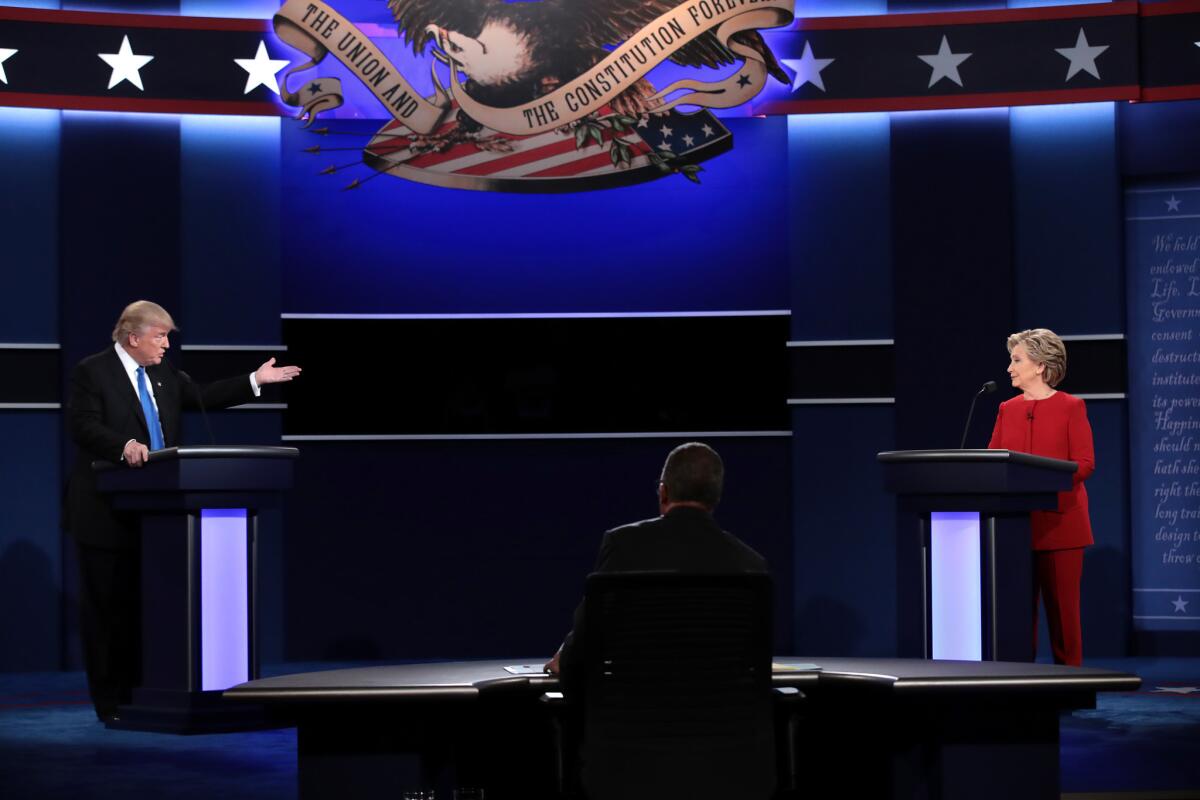Donald Trump just said Hillary Clinton only now is focusing on trade. That’s not true.

- Share via
Keeping with the populist theme of his campaign, Donald Trump blamed bad trade deals for America’s uneven economic recovery and accused Hillary Clinton for only recently focusing attention on jobs lost overseas.
“Companies are leaving. They’re leaving in bigger numbers than ever,” Trump said in Monday night’s debate, pointing to recent examples of Carrier and Nabisco moving their production overseas.
Trump accused Clinton of only focusing on trade once the GOP nominee made it a centerpiece of his campaign.
“You’ve been doing this for 30 years,” Trump asked Clinton. “Why are you just starting to think about this now?”
But Clinton has weighed in on trade agreements repeatedly — with varying levels of support — during her long public service, including the North American Free Trade Agreement, which went into effect in 1994. The agreement was negotiated and signed by President George H.W. Bush (not, as Trump often claims, President Bill Clinton, who was an avid supporter and pushed the pact’s final approval through Congress).
As first lady, Hillary Clinton backed the NAFTA agreement, but she has since shifted her position on the deal, calling it “flawed” during her 2000 Senate campaign and advocating for changes to the pact during her 2008 presidential run.
Trump has pointed to the trade deficit — the extent to which the United States imports more goods than it exports — to illustrate America’s weakened standing in the global economy. Last year, the country’s trade deficit for goods was around $763 billion, according to the U.S. census.
Trump has particularly focused on America’s trade with China — which last year ran at a deficit of nearly $345 billion — and Mexico, where the trade deficit was $60 billion in 2015.
But many economists say the import/export balance is an overly simplistic way to measure winners and losers on trade. Supporters of trade with Mexico, for example, often cite a study by the Wilson Center, a Washington-based nonpartisan think tank, which estimated that 40% of the content in goods imported from Mexico originates in the United States.
Some companies targeted by Trump for moving their operations overseas say the real estate magnate is misstating their operations and its effect on American workers. Ford Chief Executive Mark Fields said this month that while the company is building a new factory in Mexico to build cars, the company’s American workers would not be affected.
Trump frequently laments that America “doesn’t win anymore” and points to the country’s economy as proof. He frequently cites the nation’s lagging growth — the economy only expanded by an unimpressive 1.2% in the second quarter of this year.
But Trump often points to incorrect or exaggerated figures to bolster his bleak portrayal of the country’s economic health. He has said that more than 94 million people are outside the labor force, implying all of those Americans are seeking but unable to find jobs.
According to the Bureau of Labor Statistics, 7.8 million people are unemployed and actively looking for a job, leading to the current 4.9% unemployment rate. BLS explains that many of those aren’t in the workforce are retired, disabled or ill, or had responsibilities at home. Others may want to work but have given up the job search in frustration.
Clinton, meanwhile, has struck a rosier, albeit cautious tone about the post-recession recovery. She has touted the economic rebound under President Obama, but has attempted to veer away from sounding too triumphant, in fear of alienating voters who still feel economically fragile.
At times, she has exaggerated the extent of the economic turnaround. She has referred to 15 million new jobs created under the Obama administration, but the Washington Post Fact Checker has said such a figure is misleading because it begins its count in February 2010, more than a year into Obama’s presidency.
Trump has put particular emphasis on the country’s troubled manufacturing sector. Such jobs had fallen as a share of the country’s non-farm jobs since the end of World War II, but there was a particularly sharp decline between 2000 and 2009. Factory jobs have rebounded a bit over the last six years; since then, U.S. manufacturers have hired around 740,000 new workers.
Follow @melmason for the latest on national politics.
ALSO
Donald Trump revises his economic plan but leaves many questions unanswered
Donald Trump vows in Rust Belt speech to punish China and end major trade deals
Plunge in job growth could fuel more turmoil in the presidential race
More to Read
Get the L.A. Times Politics newsletter
Deeply reported insights into legislation, politics and policy from Sacramento, Washington and beyond. In your inbox three times per week.
You may occasionally receive promotional content from the Los Angeles Times.











